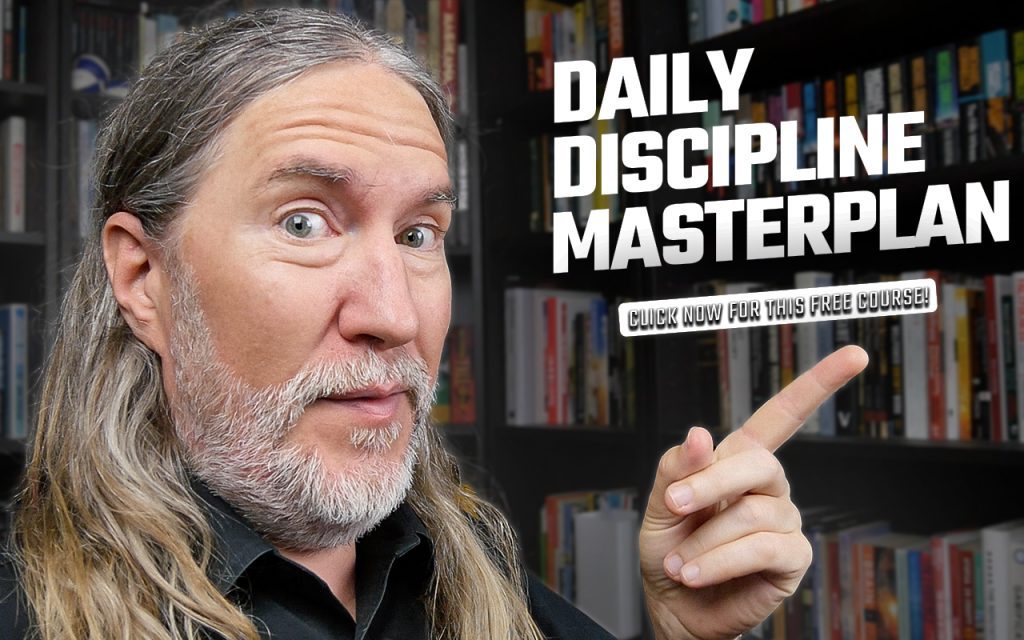Gratitude meditation turns frowns upside down.
Sounds like a goofy way of putting it, I know.
But if you want a fast path to feeling better, bringing to mind the people, experience and things that you’re grateful for literally changes your brain.
However, not even the best gratitude meditation script is going to get you the results you’re looking for without covering the bases you’re about to discover.
Get these nuances right, and your gratitude meditations can lead to experiences of peace and contentment deeper than you ever imagined possible.
You might even experience enlightenment.
I don’t throw the word ‘enlightenment’ around lightly, so if you’re ready for ways to reduce stress, instantly remove dark thoughts and feel happy fast, let’s dive in.
What Is Gratitude Meditation?
Simply put, gratitude meditation is a type of meditation the specifically involves focusing on feels of appreciate and gratitude. It’s also a kind of memory exercise because you bring images and emotions to mind using your memory.
The practice can take a few different forms, but typically you will sit or lay down and then focus on bringing to mind people and experiences and perhaps even possessions that make you happy. You can – and will also benefit from – including feelings of gratitude for yourself.
You can combine this meditation practice with breathing, stretching or walking. It’s even possible to focus on your gratitude for people as you’re talking with them. This is a wonderful thing to do. Even if it’s not strictly “meditation,” it is possible to reflect on your thankfulness for them in a way that is very close.
What Are The Benefits Of Gratitude Meditation?
Leigh Brasington is one of my favorite authorities on the matter of using gratitude as part of meditation.
That’s because he’s scientifically informed as well as steeped in tradition. In Right Concentration, he discusses why gratitude meditation improve our mental states.
“Neurologically, pīti and sukha seem to be accompanied by increased activity in the nucleus accumbens of the brain – the reward center.”
He also points to the research showing that starting to think about your gratitude helps “shut down” the default mode network of the brain. Research cited by Gary Weber in Happiness Beyond Thought finds exactly the same conclusion, something I’ve enjoyed in my own practice and shared in The Victorious Mind.
It’s really difficult to undermine the value of feeling more grateful, even if it’s just for a few minutes a day. These benefits include:
- Gratitude is proven to make you happier
- It helps you manage and reduce stress
- Enhanced self esteem
- Improved sleep
- More mindfulness that can prevent meaningless fits of anger
- Reduced loneliness
- Experiences of Zen and nondual awareness
- Connection to others and to the world
- Elevated reflection on life
There are lots of other ways to word these benefits. But as you can see, it’s a very full experience and well-worth pursuing.
7 Best Tips For Getting The Best Out Of Your Gratitude Meditation
As we go through these tips, there’s no special order.
But they all do matter.
I would suggest that instead of trying to “get it right,” experiment and explore.
One: Start Small But Be All In
A lot of people make the mistake of trying to bite more than they can chew.
They might hear about enlightenment and then get discouraged that they haven’t achieved it after five minutes, five days, five years or five decades.
The truth is that you’re enlightened right now.
But you might have a bunch of distracting thoughts because you’re not starting small enough.
You can start small simply by sitting down and deciding to practice gratitude meditation and be grateful for that.
What an amazing life you must lead to have time for such a thing!
I know it might sound ridiculous, but some of the personal mantras I’ve memorized in Sanskrit are Zen like that. They remind me that all thoughts are ridiculous.
And that’s really the small place to begin.
And then be all in by coming back again and again to the small stuff. Enlightenment is not grandiose, after all. It is to be in love with the ordinary.
You don’t have to take it from me either. In the Christian meditative tradition, Hugh of St. Victor suggested something very similar in the twelfth century. In his book, Didascalicon, he writes:
“Once grounded in things small, you may safely strive for all.”
Two: Practice Starting From The Present
I mentioned above that gratitude meditation is also a form of memory exercise.
But that doesn’t mean you have to go deep into memory.
Instead, try starting small with the fact that you actually have time to practice this form of meditation at all and then work back to the very next thing in the past for which you’re grateful.
It could be the coffee you had with breakfast, a nice book you read or a quick chat with a friend.
Then go another step back into the past.
I call this practice “gratitude chaining.” It’s very powerful because you don’t have to think too hard about what to be grateful for. You just use time as a guide.
Three: Visualize Using All Your Senses
A lot of people make the mistake of treating visualization as only visual.
Instead, dive in and tap into all of your senses.
For example, let’s say you’re focusing on your gratitude for a coffee meeting with some colleagues.
Certainly see what the event looked like in your mind. But also feel the warm cup of coffee in your hands, hear the voices of the other people in your mind’s ear, smell the smells, taste the tastes, etc.
Making sure to bring vivid levels of memory to the experience will deepen your connection to gratitude itself and the aspects of life you’re grateful for.
Four: Drill Down
As you’re practicing, get as specific as you possibly can.
Let’s stick with the coffee meeting example.
Drill down to the coffee cup. If you know the brand of the coffee, get grateful for that too. If you don’t, spend a second expressing gratitude for the truck drivers that brought it to the cafe, the warehouse workers, the people in the factory and everyone involved in the supply chain back to the earth and the rain.
What about the paint on the walls?
The sewer system you can’t even see beneath your feet.
Gross, perhaps, but just imagine the alternative!
The more granular you get, the more you’ll benefit from experiencing just what a wondrous world we live in.
Five: Journal Your Experiences
For years I wrote down at least 10 things I felt grateful for each and every day.
This practice essentially rewired my brain.
See, I used to be super-depressed and cynical.
In fact, one of the reasons I write this blog is as an expression of gratitude for the ways that keeping a journal helped break me about of that horrible cycle.
There are a few more nuances involved, so don’t hesitate to read this full guide on journaling for self improvement here on the Self-Improvement Supercharger blog.
Six: Role Play
Let’s say you slip and get really annoyed with someone. Perhaps even angry.
In your next gratitude meditation, try to enter their lives.
This is going quite some distance beyond empathy. You’re literally trying to imagine their context so you can better understand how things are for them.
Then, when you feel like you’ve got a handle on things, send them your gratitude for the lesson you’ve just received.
For extra rewards, imagine yourself as them receiving the gratitude you’re sending. This final step will symbolically complete the circle.
Seven: Be Consistent
Oh no! Not another “stay the course” speech!
But it’s true.
Your brain can’t rewire itself without forming proper neuronal connections.
And that takes time.
Remember when I said that I kept a gratitude journal for years?
In reality, things started turning around for me after 11 days. But I kept going because I knew my own propensity for seeing things negatively.
And I’m glad I did because after nearly a decade of combining daily gratitude journaling, thinking much more positively is now a hard-wired skill.
Sometimes I still jot out 10 things I’m grateful for.
And I do dedicated sitting meditations that include gratitude each and every week as part of my “Victorious Mind” memory-based meditation practice.
But the best part is that thanks to consistency, feeling grateful now happens to me on autopilot.
And I know that with consistent practice, waves of gratitude can flow consistently over you too.
If it’s old-school to say “you have to earn it,” so be it. I’m saying it.
How Gratitude Meditation Creates Enlightenment
As I mentioned before, I believe you’re already enlightened.
If you’re still seeking peace, you might find that hard to believe.
I did too when I first heard James Swartz and people like Fred Davis make this claim.
But the more I thought about it and included reflections about the nature of consciousness and knowledge of the self in my daily meditations, I realized they’re right.
Even to be angry is to be 100% conscious. Even when you’re sleeping, your 100% conscious.
This idea is true because consciousness is the field of awareness in which experiences sit. Other ways of thinking of it include:
- The difference between your computer’s operating system and an individual software program
- Working memory and information that your working memory “hosts” so that you can understand words and create sentences
Gratitude is kind of like a cleansing software that you upload into this working memory space or operating system.
And the more often you run it, the cleaner your conscious mind becomes.
These metaphors aren’t much different than the old story about why the monk polishes his food bowl every day. The brighter it shines, the more donations he gets.
Your mind is like that bowl. Shine it consistently and not only will your conscious space be a more delightful place. You’ll also receive more things into that increase your feelings of gratitude.
It’s a win-win!
And if you need more help with the consistency part, grab this powerful free course:
So what do you say?
Are you ready to supercharge your next gratitude meditation sessions?
Make it happen!


